Question & Answer
Question
How can you determine the location of an IBM Rational ClearCase snapshot view root on Microsoft Windows, Linux or UNIX?
Answer
Unless the view was created in the default manner of having view storage directly under the view root, there is currently no command to use which can determine the location (of the view root).
The cleartool lsview -long command only lists the view tag and view storage, not the view root.
Change request (RFE) RATLC00606966 has been submitted to address this functionality. However, the decision was made by Product Management to exclude the resolution of this enhancement from future upgrades and releases due to the significant architectural changes required to implement the solution.
Locating View Root Directories
This feature of Rational ClearCase allows you to store the view root in a location that is convenient as well as separate from the view storage, which is tracked by the application.
ADVISORY: When managing view roots in this manner, it is recommended that you establish a convention for storing the view roots in a common path or central location to simplify administration.
Here are some methods for locating view root directories:
UNIX/LINUX & WINDOWS
- A list of the view root directories can be obtained by searching for occurrences of the view.dat file. Since the view.dat file is located in the root directory of every snapshot view it will list all the view root directories in the search path selected.
UNIX/LINUX ONLY
- When a snapshot view is created on UNIX or Linux, ClearCase creates or modifies the file .ccase_svreg in the users home directory. This file contains a list of all the snapshot view root locations for that user.
Example:
%> cat .ccase_svreg
188zoopq.a3md71f1xl.4dc6.34:63:77:c7:34:4a /net/host1/snaps/jdoe/snap1
263fbeab.b8d611da.9ad9.00:01:80:a2:74:3e /net/host2/viewstore/snap2
Note: ClearCase operations use information from this file. If this file is deleted or corrupted, the information must be regenerated for each snapshot view that is used. To do so, update the view with either of the following commands:
cleartool update
cleartool update -print
Note: If the permissions on the .ccase_svreg have been modified such that the write permission has been removed for the user, the following error may occur during snapshot view creation:
cleartool: Warning: Unable to register new snapshot view: The file access permissions do not allow the specified action.
The correct permission for the .ccase_svreg file is 644 (-rw-r--r--).
WINDOWS ONLY
1. The Snapshot view update tool presents a pull-down list of these views.
- Run the ClearCase Snapshot View Update tool (Start > Run type: clearviewupdate)
- The drop down list in the Start Update tool will contain a list of the snapshot view roots on the local host.
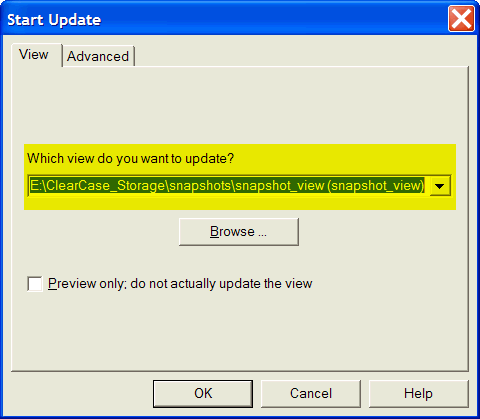
2. Edit View Properties displays the view root path:
- Open ClearCase Home Base (Start > Run type: cleardlg /viewprop)
- Click the Snapshot tab to display the view root directory.
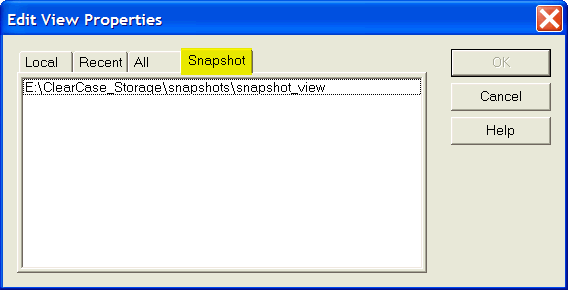
3. In ClearCase Explorer, hover over the Snapshot view shortcut to reveal the view root location.
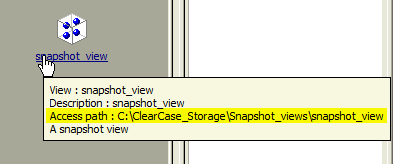
4. A review of the Snapshot view Shortcut Properties will reveal the view root location.
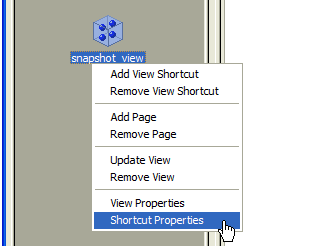
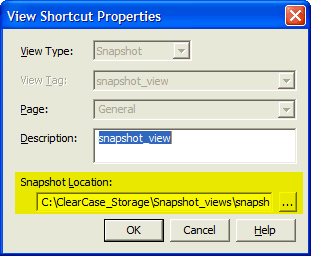
5. The location of the snapshot view root or the workspace is tracked in a registry key on the local machine.
Note: This solution contains information about modifying the system registry. Before making any modifications to the Microsoft® Registry Editor, it is strongly recommended that you make a backup of the existing registry. For more information describing how to back up the registry, refer to the Microsoft Knowledge Base article http://support.microsoft.com/kb/256986.
[HKEY_CURRENT_USER\Software\Atria\ClearCase\CurrentVersion\Workspaces]
If the workspace has been moved you will see duplicate entries in the registry. The current workspace will contain a hidden .view file. This file contains the workspace oid and view uuid. Review technote 1252064 for more information about the .view file.
Related Information
Was this topic helpful?
Document Information
Modified date:
16 June 2018
UID
swg21148996